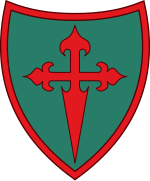
Summary
Spanish Renovation (Spanish: Renovación Española, RE) was a Spanish monarchist political party active during the Second Spanish Republic that advocated the restoration of Alfonso XIII of Spain, as opposed to Carlism. Associated with the Acción Española think-tank, the party was led by Antonio Goicoechea and José Calvo Sotelo. In 1937, during the course of the Spanish Civil War, it formally disappeared after Francisco Franco's merger of the variety of far-right organizations in the rebel zone into a single party.
Spanish Renovation Renovación Española | |
|---|---|
 | |
| Leader | Antonio Goicoechea José Calvo Sotelo |
| Founded | De facto: 16 January 1933[1] De jure: February 1933[2] |
| Dissolved | 8 March 1937[3] |
| Split from | Popular Action |
| Merged into | FET y de las JONS |
| Headquarters | Madrid, Spain |
| Ideology | Monarchism (Alfonsism) Authoritarian conservatism[4] Traditionalism[4] Totalitarianism[4] Integrism |
| Political position | Far-right |
| Party flag | |
 | |
History edit
The group was formed in January 1933 after Goicoechea and some followers split from Acción Popular and were given Alfonso's approval to form a new party, although from the outset RE maintained good relations with the Carlists and sought to bring them into various anti-Republican conspiracies.[5] Even before the Civil War RE was linked to the Falange, paying it a 10,000 peseta monthly subsidy.[6] RE espoused a kind of authoritarian statist corporatism, particularly marked after Calvo Sotelo took control of the party.[7]
The group was one of the first amongst those involved in conspiracy against the Popular Front government to endorse Franco as overall leader.[8] RE was also closely linked to the military group Unión Militar Española which played an important role in bringing about civil war.[9] During the opening stages of the civil war RE was close to General Emilio Mola, who consulted regularly with the group's leadership.[10]
The assassination of Calvo Sotelo, who was much more personally popular and a better orator than the generally ineffectual Goicoechea, in July 1936 had weakened RE somewhat and before long they became wholly subservient to Franco in an attempt to retain influence for a group that had little popular support.[11] Along with a variety of other far right groups RE disappeared in April 1937 with the formation of the Falange Española Tradicionalista y de las Juntas de Ofensiva Nacional-Sindicalista.[12] Recognising that his power base was flimsy at best Goicoechea immediately accepted the decree and dissolved RE.[13]
References edit
- ^ Goicoechea Cosculluela, Antonio (6 January 1933). "Hacia un frente contrarrevolucionario español" [Towards a Spanish Counterrevolutionary Front]. Acción Española (in Spanish). Vol. 4, no. 20. Spain. pp. 285–293. Retrieved 24 October 2019.
- ^ "La entidad Renovación Española se constituye" [Spanish Renewal is Constituted]. ABC (in Spanish). Madrid. 24 February 1933. Retrieved 24 October 2019.
- ^ Payne, Stanley G. (1961). Falange: A History of Spanish Fascism. Stanford, Calif: Stanford University Press. p. 156. ISBN 0-8047-0058-3. OCLC 371552.
- ^ a b c González Calleja, Eduardo (2008). "La violencia y sus discursos: los límites de la "fascistización" de la derecha española durante el régimen de la Segunda República". Ayer (71): 109–110. JSTOR 41325979.
- ^ Martin Blinkhorn, Carlism and crisis in Spain, 1931-1939, CUP Archive, 1975, p. 108
- ^ Antony Beevor, The Battle for Spain: The Spanish Civil War 1936-39, London: Phoenix, 2007, p. 45
- ^ Blinkhorn, Martin (19 June 2004). "Conservatism, traditionalism and fascism in Spain, 1898–1937". Fascists and Conservatives: The Radical Right and the Establishment in Twentieth-Century Europe. Routledge. p. 131. ISBN 0203-39323-6.
- ^ Paul Preston, Franco, London: Fontana, 1995, p. 125
- ^ Preston, Franco, p. 136
- ^ Preston, Franco, p. 155; p. 157
- ^ Preston, Franco, pp. 249-50
- ^ Beevor, The Battle for Spain, p. 285
- ^ Preston, Franco, p. 271
| The Popular Front (Republican) | Supporters of the Popular Front (Republican) | Nationalists (Francoist) |
|---|---|---|
|
The Popular Front was an electoral alliance formed between various left-wing and centrist parties for elections to the Cortes in 1936, in which the alliance won a majority of seats.
|
|
Virtually all Nationalist groups had very strong Roman Catholic convictions and supported the native Spanish clergy.
|


